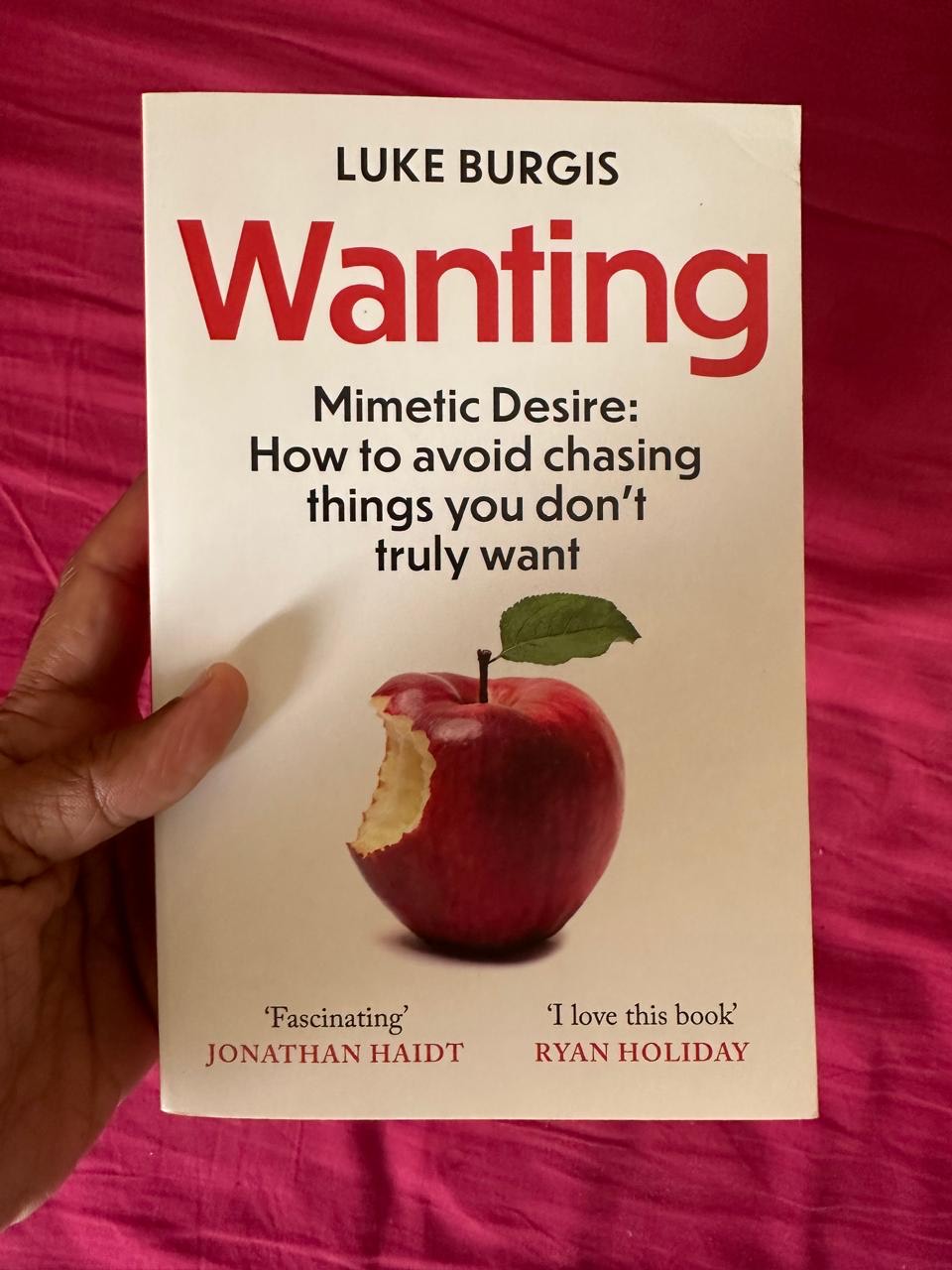
Wanting by Luke Burgis

- Binod Shankar
- Book Summary
My top 35 takeaways:
- Desire does not mean the drive for food or sex or shelter or security. Those things are better called needs—they’re hardwired into our bodies. Biological needs don’t rely on imitation. But after meeting our basic needs as creatures, we enter into the human universe of desire. And knowing what to want is much harder than knowing what to need.
- Desire (as opposed to need) is an intellectual appetite for things that you perceive to be good, but that you have no physical, instinctual basis for wanting – and that’s true whether those things are actually good or not.
- Striving for something that we do not yet possess is called desire. Desire doesn’t bring us joy because it is, by definition, always for something we feel we lack.
- Humans learn—through imitation—to want the same things other people want, just as they learn how to speak the same language and play by the same cultural rules. Imitation plays a far more pervasive role in our society than anyone had ever openly acknowledged.
- While we fight for equality in the areas that do matter e.g. for fundamental human and civil rights, we also begin fighting for equality in areas that do not matter: to make as much money as someone else, to have the same number of Instagram followers, to have the same amount of status or respect or professional prestige as any one of the nearly eight billion models on the planet.
- It’s easy to be an armchair contrarian. It’s hard to take contrarian action: to question the dominant narrative, to be honest with yourself, to tell the truth even when the immediate outcome is pain.
- An unbelieved truth is often more dangerous than a lie. The lie in this case is the idea that I want things entirely on my own, uninfluenced by others. The truth is that my desires are derivative, mediated by others.
- Desire spreads like energy. This energy can lead to a cycle of positive desire, in which healthy desires gain momentum and lead to other healthy desires, uniting people in positive ways; or it can become a cycle of negative desire, in which mimetic rivalries lead to conflict and discord.
- Positive Cyle Logic works like this. If you make superior products, elite athletes can’t help but want to wear them. If you get elite athletes to use your product, you can’t help but attract the attention of mainstream consumers. And if you attract the attention of mainstream consumers, you can’t help but build brand power. And when you have brand power, you can’t help but increase your margins.
- Thin mimetic desires abound. They’re peddled to us every minute of the day. We can nip at them, maybe even sink our teeth into them, but they won’t take us where we want to go. Our choice is between living an unintentionally mimetic life or doing the hard work of cultivating thick desires. The latter may require us to suffer from the fear of missing out on the shiny mimetic objects that surround us.
- The key is carefully curating our sources of knowledge so that we are able to get down to what is true regardless of how many other people want to believe it. And that means doing the work.
- Advertising works by making you think you’re different. The goal is getting people to think, “Oh, those lemming-like, silly people in the commercial.” The moment a person exempts themselves in their own mind from the very thing they see all around them is the moment when they are most vulnerable.
- People worry about what other people will think before they say something—which affects what they say. In other words, our perception of reality changes reality by altering the way we might otherwise act. This leads to a self-fulfilling circularity.
- Meditative thought, on the other hand, is patient thought. It is not Meditation. Meditative thought is simply slow, nonproductive thought. It’s not reactionary. It’s the kind of thought that, upon hearing news or experiencing something surprising, doesn’t immediately look for solutions. Instead, it asks a series of questions that help the asker sink down further into the reality: What is this new situation? What is behind it? Meditative thought is patient enough to allow the truth to reveal itself.
- I went from craving classical wisdom to consuming memes and tweets and tech news—which led to my imitating ideas without knowing it. I knew more about what blogger Gary Vaynerchuk had to say about happiness than Aristotle.
- The world is full of models. The business world is particularly fond of them. There are best practices, guidebooks, templates, and daily blogs claiming to offer road maps to success. There are role models on the covers of magazines and in the pages of the Wall Street Journal. There are books. Everyone is either a model or signaling that they should be.
- This natural and healthy concern in children about what other people want seems to morph in adulthood into an unhealthy concern about what other people want. It grows into mimesis. Adults do expertly what babies do clumsily.
- People are drawn to others who seem to play by different rules. We are generally fascinated with people who have a different relationship to desire, real or perceived. When people don’t seem to care what other people want or don’t want the same things, they seem otherworldly.
- Nobody wants to be known as an imitator—except in very specific cases. We encourage children to imitate role models, and most artists generally recognise the value of imitating the masters. But imagine if two friends started showing up at every social gathering wearing matching clothes, if someone constantly mimicked the mannerisms of coworkers. These things would be considered strange, rude, or insulting, if not infuriating. It’s as if everyone is saying, “Imitate me—but not too much,” because while everyone’s flattered by imitation, being copied too closely feels threatening.
- People are desperate to find something solid to hold on to in today’s “liquid modernity” (to borrow a term from sociologist and philosopher Zygmunt Bauman). Liquid modernity is a chaotic phase of history in which there are no culturally agreed-upon models to follow, no fixed points of reference.
- The fastest way to become an expert is to convince a few of the right people to call you an expert.
- It’s less likely that experts will be mimetically chosen in the hard sciences (physics, math, chemistry) because people have to show their work. But it’s easy for someone to become an overnight expert on “productivity” merely because they got published in the right place. Scientism fools people because it is a mimetic game dressed up as science.
- There’s a model for everyone—someone ready to impart the specific knowledge needed to be happy and make people feel that they have escaped the fate of the masses. But any model who bills themself as this kind of expert is a charlatan.
- The German political scientist Elisabeth Noelle-Neumann coined the term “spiral of silence” in 1974 to refer to a phenomenon that we see often today: people’s willingness to speak freely depends upon their unconscious perceptions of how popular their opinions are. People who believe their opinions are not shared by anyone else are more likely to remain quiet; their silence itself increases the impression that no one else thinks as they do; this increases their feelings of isolation and artificially inflates the confidence of those with the majority opinion.
- Empathy is the ability to share in another person’s experience—but without imitating them and without identifying with them to the point that one’s own individuality and self-possession are lost. In this sense, empathy is anti-mimetic.
- Understand core motivational desires. It seems simple, but nobody does it. Ask yourself: How many people do you work with who could name even one of your most meaningful achievements and explain why it was so meaningful to you?
- Mimetic desire often leads people into unnecessary competition and rivalry with one another in an infernal game of status anxiety.
- By mapping out the system of desire that you’re enmeshed in (and probably have been your whole life), you can begin to take some critical distance from it.
- Most of all: know where your desires came from. Your desires have a history. You can’t know what a ‘true’ or ‘authentic’ desire is unless you understand where it came from – and that involves diving deep into your past, understanding how you have evolved as a person, and seeing which desires have been with you for a long time and which ones have come and gone like the wind.
- Social media platforms thrive on mimesis.
- The first step toward freeing ourselves from the degrading slavery of being merely a child of our age (to paraphrase G.K. Chesterton) is to get the lay of the land — to step back, create distance from the systems of desire that we’re part of, and to try to see them for what they are.
- You might not be the sole author of your desires, but you can certainly take ownership and put your mark of authorship on them through your creative freedom.
- To be anti-mimetic is to be free from the unintentional following of desires without knowing where they came from; it’s freedom from the herd mentality; freedom from the ‘default’ mode that causes us to pursue things without examining why.
- Someone with strong underlying values – whether they be religious or philosophical or have another basis – is usually less susceptible to the winds of unhealthy or temporary mimetic desires that lack substance.
- Perhaps the most anti-mimetic attitude of all is an openness to wonder and a desire to let reality surprise you. It rarely disappoints.
To know more visit our website!



